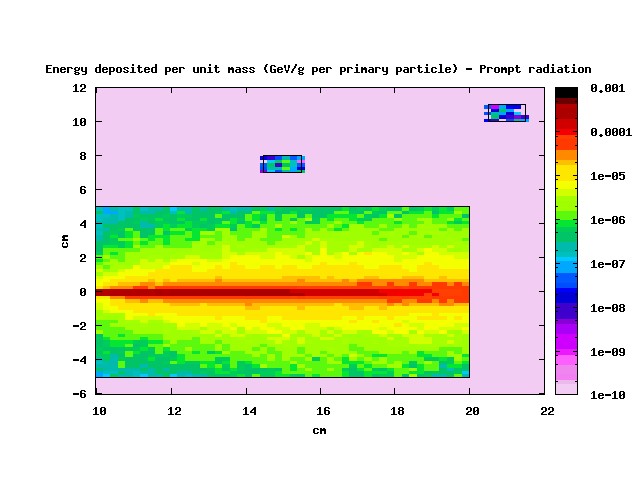Date: Tue, 02 Oct 2012 04:11:46 +0200
Hallo Patrick,
I start with your question about the units. You have chosen only a DCYTIMES
value, with negative time (-100.). This does NOT mean that you are scoring
prompt radiation, but it means that you are scoring the residual radiation
(the radiation due to the activated materials) during the irradiation, at
t=-100 s.
The units in this case are the same as the units in the case of "positive"
cooling times (times after the end of the irradiation): GeV/g per unit time
(s), due to a proton beam of 10⁶ protons/s. You realize this if you score
separately the prompt radiation simply by using another USRBIN card not
related to DCYTIMES. I did for you in the attached input, you can see the
difference (I added some other distributions that could be of interest). If
you look at the result for the prompt 'dose' (USRBIN at LU=26) you see the
deposited energy
(in GeV/g per primary) in both the watercontainers (it is the energy deposited
by the primary beam and eventually by the secondaries produced by the
interactions of the primary beam). If you look at the residual quantities
(USRBIN at LU=23) you evaluate the energy deposited by the radioactive
nuclides, then you have to accumulate a certain statistics because you have to
consider the probability to produce the radioactive nucleus and the
probability of this one to decay (and consider that you get tritium in the
water...).
The container closer to the target is more irradiated and then produced more
radionuclides and then you see it for the first, but with an appropriate
statistics you obtain results different from zero for both the containers.
This works well also using the region binning (with your input I saw values
different from zero with about 50000 primary events).
Kind regards,
Anna
Am Fri, 21 Sep 2012 10:52:43 +0200 schrieb Patrick Dethlof
<patrick.dethlof_at_gmail.com>:
> Hello.
>
> I tried i first simulation for testing purpose with raddecay on and an
> irradiation profile.
> I am scoring with DCYtimes at a negative time (scoring primary radiation).
> I have a little gold target which is hit by a 1GeV Proton Beam.
> There are also two water container (water1 with larger distance as water2
> to gold target).
>
> I am scoring energy deposit in different ways. First with a region binning.
> Result: Only energy deposit in water2 not water 1.
>
> Second way: I am scoring with a large binning grid and the result is that
> there is ernergy deposit in both watercontainers.
> Way is there a different? I think the region binning is wrong( i mean i did
> something wrong but what?)
>
> The second question is about the units. Because am scoring with a negative
> time in raddecay the unit is energy/primary?
> Or is it energy / unit time?
>
> Thanks alot
>
> Patrick
>
> 2012/9/19 Anna Ferrari <a.ferrari_at_hzdr.de>
>
>> Hallo Patrick,
>>
>> yes it is possible! A very useful feature of the FLUKA code is that the
>> generation and transport of the residual radiation is possible during the
>> same
>> simulation where the radionuclide production is calculated. You can give in
>> input your proper irradiation profile and get in the same runs the results
>> for the production of the residuals in your water container, their time
>> evolution and the residual doses corresponding to the cooling times you
>> want to know.
>>
>> To be guided you can look at the Lecture:
>>
>> https://www.fluka.org/free_download/course/jlab2012/Lectures/18_Activation_0412.pdf
>>
>> and also at the exercice that follows.
>>
>> Regards,
>>
>> Anna
>>
>>
>> -----Original Message-----
>> From: owner-fluka-discuss_at_mi.infn.it [mailto:
>> owner-fluka-discuss_at_mi.infn.it] On Behalf Of Patrick Dethlof
>> Sent: 19 September 2012 11:38
>> To: fluka-discuss_at_fluka.org
>> Subject: Dose or Dose-rate of Activation radiation
>>
>> Hello everybody,
>>
>> i am doing some activation simulations. Now my interst is the dose placed
>> by
>> the radiation of produced nuclides in a water container near the target.
>> Is this possible with FLuka?
>>
>> Thanks
>>
>> Patrick Dethlof
>>
>>
>>
>>
>>
>>
- application/octet-stream attachment: run_v4.inp
